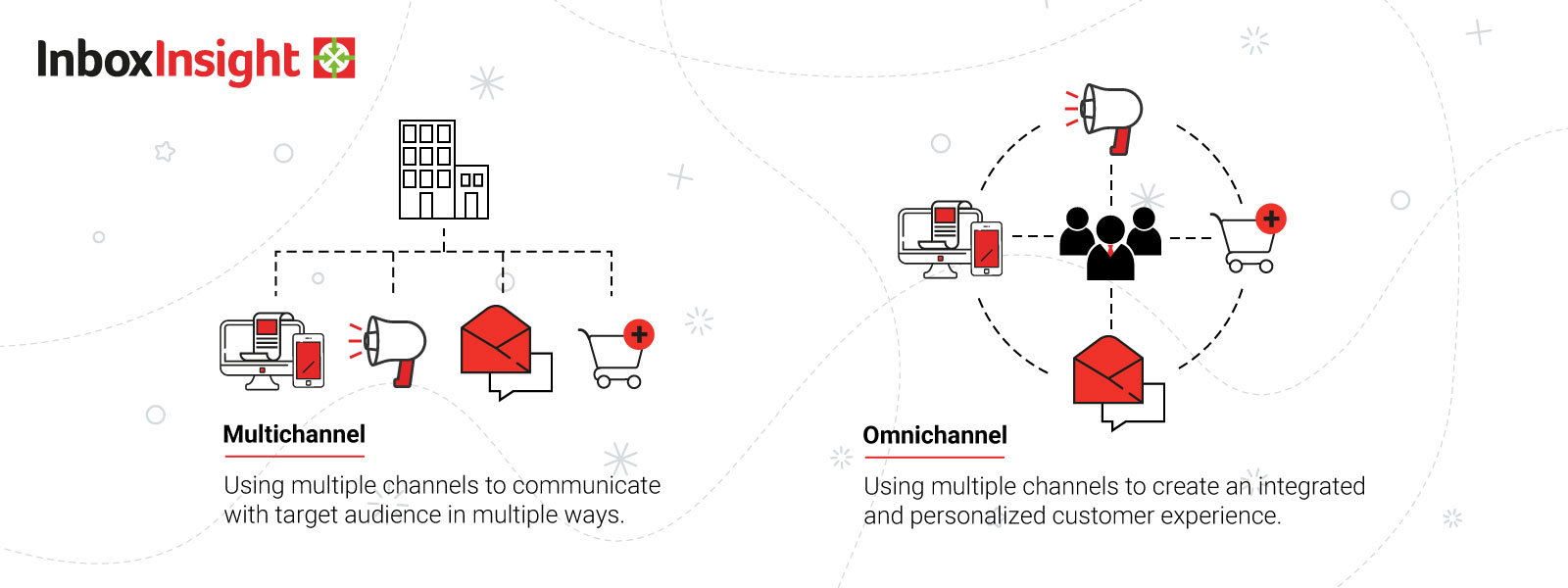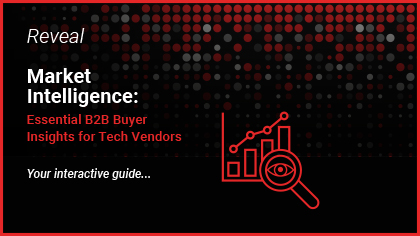Understanding the importance of multichannel in B2B marketing is one thing, but understanding what all of the related acronyms, tactics and individual channels is an entirely different challenge.
Channel integration is key to a successful B2B multichannel strategy when it comes to creating seamless cross-channel experiences, hence why recognizing key terms can really help to further inform your strategy and drive your multichannel approach forwards.
Reading time: 6 minutes
This jargon-busting glossary of multichannel terms will help B2B marketers understand the multichannel landscape, enable them to better utilize the digital channels at their fingertips and provide a more consistent customer experience as a result.
What is multichannel marketing?
Multichannel marketing centers heavily on driving engagement and reach with your target audience. It combines various different marketing channels to communicate and distribute your brand’s message, aiming to deliver consistent messaging across separate channels.
Each channel plays a key role in achieving this, which is why monitoring channel performance is so important to determine key focus areas such as budget allocation – especially as cost is a top consideration factor when it comes to deciding which channels to utilize according to 60% of US and 56% of UK senior B2B marketing professionals.
Countless channels now exist in light of advancements in technology and changing behaviors, prompting 40% of senior B2B marketers to cite ‘budget spread too thinly across channels’ as their biggest obstacle, while almost a third (29%) find ‘providing a seamless multichannel experience’ a key challenge. The expertise required to fully understand all channels, terminology, and how these fit with the bigger picture is evidently challenging – even for experienced marketers.
On the other hand, omnichannel marketing is a newer and more integrated approach to marketing. It involves using multiple channels, such as websites, mobile apps, and social media, to create a unified and seamless experience for customers. Omnichannel marketing seeks to create a consistent and personalized experience across all channels, making it easier and more convenient for customers to interact with a brand.

Learn the lingo: Multichannel glossary
To help you master the world of multichannel we’ve put together a list of the most common key terms, concepts and acronyms that you’ll likely come across with increasing frequency, as more businesses adopt a multichannel approach in their B2B marketing strategies.
Account-based advertising (ABA)
ABA targets best-fit accounts through digital ad campaigns that focus on account level with high revenue potential, rather than individual leads.
Affiliate advertising
Affiliate advertising is an advertising model where businesses reward third-party publishers (affiliates) for traffic or leads to their products or services as a result of the affiliate’s own marketing efforts.
Bidding
In paid search, marketers bid the maximum amount of money they are willing to pay for each click on their ads. Which ad to run is determined by a behind the scenes auction – the outcome of which informs the platform how much each advertiser will pay for their ad to be delivered to their target audience.
Brand awareness
A heavily debated area within marketing as it is traditionally hard to measure and therefore pushed aside for more tangible results when pressure is applied to demonstrate ROI. What it comes down to, is the extent to which customers are able to recognize and recall a company simply by becoming familiar with their brand.
Channels
Channels refer to the routes used to distribute and communicate a brands’ messaging to reach an audience. This can include email, paid search, paid social, organic social, programmatic display, direct marketing and so on.
Channel alignment
A true multichannel approach requires all components of your channel activity to align to your overarching strategy. A good place to begin is by analyzing how your individual channel objectives address your primary agenda.
Content amplification
Content amplification is an effective digital marketing tactic that can help to increase the visibility of content. It is the process of sharing content on multiple channels and platforms to gain exposure and visibility, often used to boost brand awareness and reach a wider audience.
Conversion
Conversion is the point at which a prospect responds to a call to action from your marketing methods and performs the desired action. The aim in B2B marketing is to drive conversions.
Cross channel experience
Achieving the optimal, seamless cross-channel experience requires the adoption of a blend of best-in-class tactics and a focus on cross-channel marketing. The experience itself is based around delivering a consistent message across all channels, so that the experience across all channels is fully integrated and unified.
Demand generation
Demand generation is a campaign strategy that creates awareness and interest in a product or service. It is used to attract potential customers and generate leads, and is a vital component of any successful marketing strategy.
Direct display
Direct display is the general advertising on websites, social media and apps via images, video, banners or other ad formats, to ultimately deliver brand messages to audiences.
Direct marketing
Direct marketing allows marketers to target those with known or potential interest in their product or service offering, selling products or services directly to them. The aim is predominantly for direct response rather than brand-building objectives, hence why personalization is a key factor in direct marketing.
Email is a key and powerful communication channel for delivering brand messages (via newsletters, for example) to those in your CRM. A form of direct marketing, this channel is 2nd most critical to strategy according to a quarter (25%) of senior B2B marketers.
Front of mind awareness
Front of mind awareness refers to the first brand that automatically comes to mind when asked about a specific product, service or industry. Achieving this is what all brands aim for.
Mobile
Mobile is the channel used by consumers to access a retailer’s ecommerce sites or apps, most commonly on a smartphone device – with 4 out of 5 people now using these to shop.
Multichannel
Multichannel is the combination of various channels to communicate and distribute your brand’s message, aiming to deliver consistent messaging across all channels.
Multichannel experience
A multichannel experience delivers a fully integrated and unified experience across every channel in your channel mix, to ensure channel alignment and message consistency.
Multichannel strategy
We can’t talk about multichannel without mentioning multichannel strategy. It’s all about being flexible, adaptive and innovative – allowing you to readily adjust your channel strategy when required and make it pioneering above competitors.
Nurture
Nurture is the process of placing content in front of prospective buyers at specific stages in their buyer journey. You are subtly, yet effectively, presenting them with regular doses of key information before they even ask for it.
Organic social
Organic social covers any form of social media marketing without any form of paid promotion activity. It can be difficult to cut through the oversaturated content environment of organic social to get seen on the right people’s feeds – as demonstrated by low reach ratios.
Paid search
The key to this channel working effectively is to master bidding strategies and optimization techniques. Paid search – along with paid social – helps to reach greater audiences while enabling organic content to reach its maximum potential, all through pay per click (PPC) ads or cost per thousand impressions (CPM).
Paid social
Social platforms are swayed towards the monetarization of sponsored posts, hence why paid social is a highly utilized channel and why almost half (46.5%) of senior marketing professionals are intending to invest more in this channel in 2022. Paid social involves displaying sponsored ads on third-party social networking platforms to target specific audiences, paying for the right to do so.
Running both organic and paid social concurrently in your multichannel strategy can help make these platforms work more effectively.
PPC
Pay Per Click. An online advertising model used to drive traffic to websites, with advertisers paying a fee every time one of their ads is clicked. Advertisers bid on click values based on keywords, platforms and audiences.
PR (Public Relations)
PR is the set of strategies and techniques determining how a company (or individual) is portrayed to the public – particularly in the media – through the information disclosed.
Programmatic display
Programmatic display a set of technologies allowing advertisers to place online display ads in front of target audiences while they are browsing publisher sits carrying the ad. This involves automated, real-time bidding in the attempt to place an ad in front of specific, in-market audiences.
Remarketing
Remarketing refers to customizing display ads to regain people who have previously visited your site. This involves placing ads in other places, including blogs and news websites, with custom messages to attract them back to your site with the aim of converting once on there.
Sales outreach
Sales outrach is the direct or indirect process of reaching out and engaging with prospects, with the ultimate goal of conversion. This can be achieved via a multichannel approach to engage them at multiple touchpoints.
Third party profiles
An authorized agency, such as a digital marketing agency, who manages business information about a ‘business profile’ for a company they do not own would be a third party profile. They are often utilized for their expertise in a field you may lack the necessary in-house skills and knowledge of, allowing your valuable time and efforts to be focused elsewhere.
Driving your B2B multichannel strategy forward
As you can tell, multichannel is an area of B2B marketing that has continually evolved over the years and as technologies have developed. It is still widely utilized by B2B marketers in today’s digitalized world, playing a pivotal role in helping them achieve their marketing objectives, increase brand awareness and reach greater target audiences.
Now you’re equipped with all the latest multichannel lingo, see how implementing a B2B multichannel strategy can really drive your brand forward.









